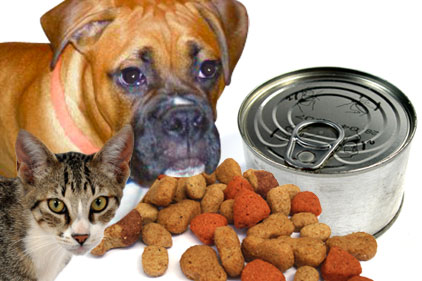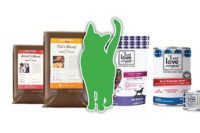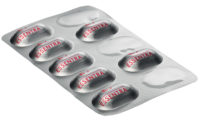
Global Industry Analysts, Inc.(www.strategyr.com) predicted that the global pet food market will reach $95.7 billion by 2017. GIA also noted that the pet food industry is considered one of the fastest-growing food industry segments. Why? The most important factor is consumer attitude driving the market. Due to lifestyle changes and an increase in single-person families, more than ever pets are considered members of the family. This shift in attitude is driving new and better products and more innovative and sustainable packaging.
We are certainly in a time of heightened awareness of ingredients, allergies, nutrition and weight control. And not just for our food, but for our pet’s food too. Owners are searching for packaging that clearly lets them see what’s inside and what nutritional needs are being met.
Blackwood Pet Food received a packaging redesign byIdeas that Kick (www.ideasthatkick.com) that helped consumers see just that. Kick was tasked with creating packaging that would help dog owners find the right food for the specific needs of their pet.
“We leveraged insights into the primary pet caregiver in the home, the ‘dog Mom,’” says Scott Behmer, account director at Kick. “She wants to be more informed about what she’s feeding her dog, so our designs place key nutritional information on the front of the bag in an easy-to-understand format.”
In response to growing consumer desire for nutritional cat food,CROWN Food Europe – Cans and Closures (www.crowncork.com), a business unit of Crown Holdings, launched premium, single-serve 3-ounce portion cat food packaging.
“Consumers are paying greater attention to the overall health and wellness of their families, and that mindset has extended to their cats,” says Hella Gourven, Marketing Manager, CROWN Food Packaging North America. “This desire for cat food with higher nutritional value has led many brands to launch premium products, including lines that are natural or organic or focus on special diet needs. Since consumers are often paying more for these products, it’s critical that the packaging delivers value on multiple levels. Along with protecting the quality and taste, it should also respond to consumer demands for convenience and environmentally friendly packaging.”
Crown’s aluminum container protects the nutritional value of the food and extends the shelf life. In addition, the small container is ideal for single-serving sizes; helping consumers control the portions they feed to their cats and minimize waste. The metal can is 100% recyclable and is produced with more than 50% recycled material.
As always, eco-friendly packaging is a consumer preference and pet food packaging is no exception.
Benchmark pet food products turned toHOOD Packaging(www.hoodpkg.com) and its EB 1 pet food bag to carry its quality dog food. The EB1 bag is a process-printed plastic package that looks like a laminated bag, and boasts similar grease barrier and strength properties, but isn’t.
According to Richard Pileski, sales manager of Hood Packaging’s Burlington, Ontario plant, the package is not only fully recyclable, but it also eliminates the lamination step as well as the need to extrude a second film. “As a result, when compared to a similar laminated bag, EB 1 uses significantly less energy to produce and substantially cuts green house gas emissions,” he says.
The EB 1 bag was designed to meet customer demands. “Our customers were telling us that they wanted to have a bag that had the performance properties of a laminated structure, the recyclability of a PE bag, and outstanding shelf appeal,” Pileski adds.
Eagle Flexible Packaging, Inc.(www.eagleflexible.com) also provides eco-friendly pet food packaging with its NVIRO Flexible Packaging. Steve’s Real Food uses the application for its natural, raw pet food. The packaging is comprised of renewable and compostable materials and is printed and laminated with less than 5% volatile organic compound (VOC) water-based inks and adhesives. In addition, the bag will compost in 10-40 days in a municipal composting environment.
In this segment, manufacturers must perform to meet changing consumer needs as it relates to the environment, the love of their pet and all that that encompasses. As a mother of two adorable boxers, I know of the importance of pet food and its packaging and I’m excited to see where these trends lead us.
A Bird’s Eye View: Insights from a pet food packaging vendor
Tom Bellmore, marketing manager and Steve Dennis, product development manager from Bemis Flexible Packaging (www.bemis.com) disclose trends in the pet food market.
FBP:What is a top concern in pet food packaging and what solutions are there?
Bemis: The pet food market is highly competitive. High quality printing and service are a given in this segment, while innovation, cost savings, and value-added functionality, are keys to long-term success.
Value-added functionality to the package can manifest itself in many ways. It can be through the use of innovative materials, various reclose options, development of films with specific tear properties, laser scoring, package design, etc. As the super-premium segment in the pet food market continues to grow, these value-added features become more of a consideration.
FBP: Have you noticed an increase in healthier ingredients in pet food? If so, what does that mean for the packaging of these products?
Bemis: The reduction of preservatives translates into a greater expectation of the packaging. Packaging does more than convey a message and transport product, it works to maintain product freshness until consumed. Where a non-barrier package was acceptable may no longer be the case once preservative-type components are removed or reduced. Packaging picks up where preservatives leave off.
FBP: Is there any more (or less) interest in “green” packaging in pet foods versus other food packaging markets?
Bemis: Interest is always there and continues to be a topic of discussion. The replacement of petroleum-based components with those derived from renewable resources without adding an excessive amount of cost from either the packaging itself or losses in fill/pack efficiencies are of the most interest. “Green” is here to stay and we as a supplier need to be sensitive to those needs and desires.



